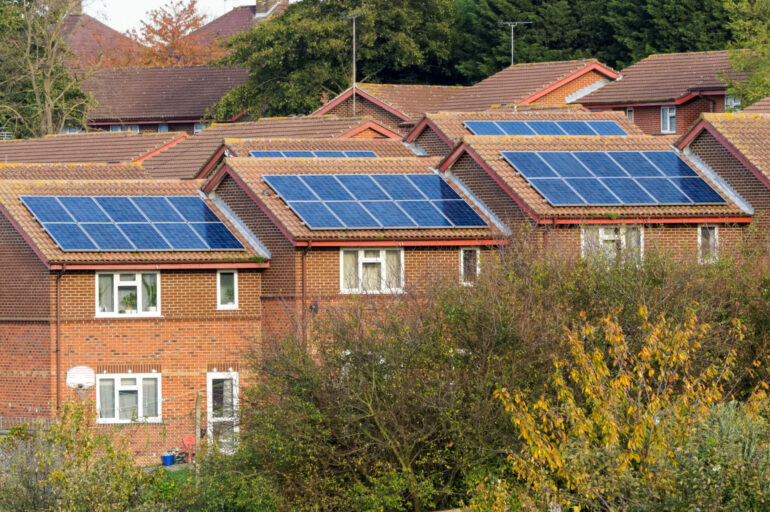The strategy behind the Government’s 2050 net-zero target is yet to be given the momentum it needs if it is to meet the ambitious deadlines set out.
Looking at the market share of responsibilities and involvement across industries, the housing and residential mortgage sector accounts for over 20% in meeting net-zero targets.
The industry therefore faces huge pressures to meet the goals set out and support consumers in making their homes more environmentally friendly.
In light of this, Mortgage Advice Bureau hosted a Green Mortgage Event with mortgage intermediaries, lenders, and investors in attendance to discuss the many challenges the property and mortgage sector is facing against the backdrop of the ‘green agenda’, and what the industry can do in order to help reach the goals set out.
Currently circa 53% of housing stock in the UK is an EPC rating of D or below, making them ineligible for many of the green mortgage products on offer.
Recent research from Mortgage Advice Bureau also found that two-fifths (41%) of UK adults don’t know what their property’s EPC rating is, highlighting a wider issue that perhaps many don’t fully understand how much carbon their homes are emitting.
Speaking at the event, Ben Thompson, deputy CEO of Mortgage Advice Bureau (MAB), described the opportunity for lenders and brokers to collectively educate and generate the right type of mortgages for consumers to make energy-efficient improvements to their homes.
Thompson said: “The median energy efficiency score of properties across the UK is similar, but worryingly the averages all sit below a C rating.
“This is a nationwide problem, and therefore a national UK opportunity. Lenders and intermediaries have a magnitude of a task ahead in order to raise awareness, educate, and help households and businesses make their buildings healthier, more comfortable, and more valuable, particularly when we think about the scale of the 2050 commitment.
“We have a responsibility as lenders and intermediaries to also hold the line on various dates pertaining to the property market and EPC rating, and we must not allow them to be pushed back.”
As a guest speaker at the event, Jessica Sansom, sustainability director of Huel, raised the importance of education. “If you don’t help people to use a product properly, it actually won’t make a difference,” she said.
She noted market forces are imperative in the housing industry to really instigate change, but that lenders need to ensure their products deliver on the front side as well as the back side.
This includes informing consumers not only what a green mortgage product will do, but how their money attached to a mortgage is invested.
Mortgage Advice Bureau rounded off the event by producing four commitments in principle with the industry representatives in attendance to focus efforts to help meet the 2050 net-zero targets. They are:
- Greater cross-industry support. Lenders and brokers, and the wider industry, are working towards their green agendas, but currently they are working in silo. If we are to build any momentum and drive the green agenda forward, more collaboration and cross-party support is needed between intermediaries, lenders, UK Finance, the Association of Mortgage Intermediaries (AMI), the Intermediary Mortgage Lender Association (IMLA), and the FCA.
- Product innovation and construction in sub-c categories. Most green mortgage products are currently only available to those who already have a property with an EPC rating of A,B, or C, but a huge amount of housing stock remains at a D level or below. A review of what mortgage products are on offer is required to incentivise those who do not currently meet criteria.
- Shift the construct of sourcing systems. In all customer cases, whether a re-finance or purchase opportunity, lenders and brokers should present a green mortgage and normal mortgage product option to give customers the choice and help educate them about the products available. With the aim of this becoming a standardised process, we can look towards removing the labelling of ‘green’ mortgage products, so they become the norm.
- Review the pricing of green mortgage products. Pricing remains one of the main considerations for consumers, and a barrier for many. The industry must review how these options compare to ‘normal’ product options if they are going to incentivise customers.
Thompson concluded: “Mortgage Advice Bureau serves genuine social purpose – we already help people to move home, improve their homes, and be protected as best they can be when things go wrong.
“However, 2050 net-zero gives us yet more relevance and social purpose. MAB considers itself a very willing trial partner to all those who attended the event, and will try to fail things with lenders, work on sourcing systems, and commit to raising more awareness around green mortgages.
“We are willing to tackle the challenge and face the current issues head-on.”



